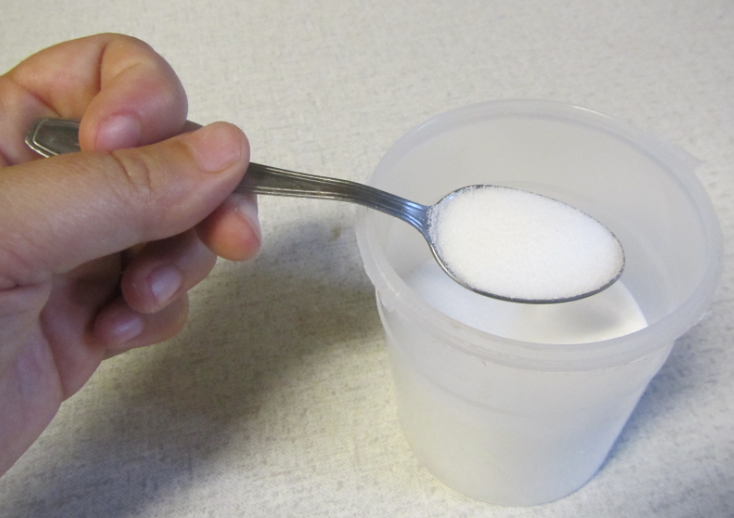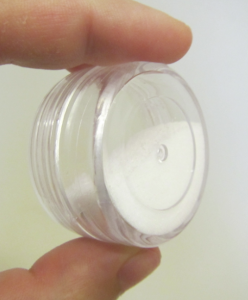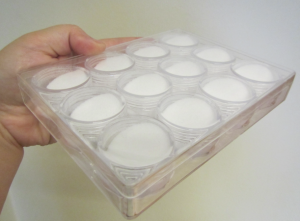
How much salt is there in sea water?
Visualization of how much salt is actually contained in sea water.
When preparing “sea water samples” for class, it is always astonishing to me how much salt I have to add for normal open-ocean salinities. Time and time again it looks like it should be way too much, but then when tasting it, it tastes salty, but like the ocean and not like brine.

A teaspoon full of salt corresponds to approximately 5 grams. That means that for typical open-ocean salinities, you have to add 7 teaspoons full of salt to a liter of water.
Since it is still astonishing to us, Pierre and I thought, it would probably be a good thing to show to our students. 0.18 teaspoon full of salt corresponds to only 1 gram of salt (averaged over several non-scientific internet sources, but well within the measurement error of my kitchen scales [and yes, I know the trick of measuring the weight of several spoons and then dividing by the number, but thanks!]).
What I want to do in the lecture is have the students estimate how much salt they need for a 35 psu liter of water. And not estimate by weighing (because I want each of the students to be able to touch the salt, but at the same time don’t want salt all over the lecture theatre), but visually estimate.

10 grams of salt in a little plastic jar.
The little jar in the picture above contains 10 grams of salt. So in order to have students estimate how much salt they would need for a liter of 35psu water, we filled 12 of those little jars with 10 grams each and handed them to the students. Obviously we didn’t tell the students how much salt was contained in a jar!

12 x 10 grams of salt. It does look like a lot more, doesn’t it?
Knowing that there are 10 grams of salt in each of the jars, it is pretty obvious that we need three and a half of those little jars for 35 grams of salt. When we did this in the lecture on Tuesday – and again, the students were not told how much salt was in one jar! -, the first person who answered guessed “four”. And then someone actually said “three and a half”. Oh well, lucky guess or great skill? I was hoping for answers like “maybe one of those jars”, because that would be closer to my own intuition. I guess next time I’ll be framing it differently. Maybe use something with one liter volume and put 35 grams in it? Or ask them to tell me in teaspoons? Does anyone have a good idea that they would like to share with me?
Scott Wright says:
You are adding weight to that glass of water as you add the salt. So the percentage of salt needed changes. After adding the prescribed amount of salt, the whole mixture is heavier, meaning the percentage of salt is less now, and you still need to add some more salt. If you take away 3.5% of something, you need to add more than 3.5% of what is left to make it whole again!
I think your students need to know that. 100-3.5%=96.5. 96.5=3.5%=99.8775.
In other words, If you start with 1000 grams of seawater, and take out the salt (3.5grams), you’d be left with 996.5 grams. So, you need to start with 996.5 grams of fresh water, and add 3.5 grams to that…or add more than 3.5 grams to the 1000 grams of fresh water. On a small scale it doesn’t seem like much, but if you tried it on the ocean, you’d likely kill everything.
Scott Wright says:
OK…I see I misstated the math …but you get the idea. It’s actually 10 times worse than I stated.
Mirjam says:
You are correct in saying that what I am writing above is simplified, but a liter is a measure of volume, not weight. What you are describing refers to estimating the salinity of 1000g seawater, not 1l.
Joe Blake says:
Do a taste test. Get some actual sea water for comparison, slowly add measured amounts of salt to filtered tap water until they taste the same. Average the results across the whole class. See how closely the result is to 35 g/l.
Ben Thums says:
Ask them how much salt you would need to add to a 12oz glass of
water to increase the salinity to 12oz of open-ocean water
Guest post: Using seawater to make bread! – Mirjam S. Glessmer says:
[…] to 300g of water which makes 26.66g per litre, whereas sea water (according to Mirjam’s 2013 blog is 35g/litre so this should mean that the sea bread loaf should be around 30% more salty than […]